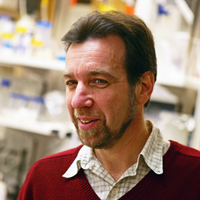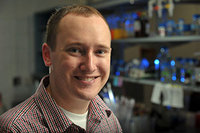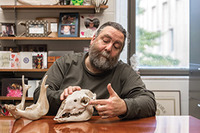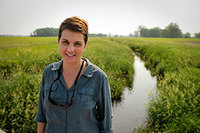Senior John Huber awarded Gates Cambridge scholarship

This prestigious postgraduate scholarship program, which fully funds postgraduate study and research in any subject at the University of Cambridge, was established through a $210 million donation to the University of Cambridge from the Bill and Melinda Gates Foundation in 2000; this remains the largest single donation to a U.K. university.
Biology major, Alexis Doyle, named Rhodes Scholar

Doyle, of Los Altos, California, and Watkins, a native of Blacksburg, Virginia, are two of 32 Rhodes Scholars selected from a pool of 882 candidates who had been endorsed by their colleges and universities. They are Notre Dame’s 18th and 19th Rhodes Scholars and will commence their studies at Oxford University in October.
Notre Dame researchers to lead NSF Dimensions of Biodiversity study

The study will focus on the apple maggot fly, Rhagoletis pomonella, and the parasitoid wasps that attack the fly.
Researchers to pursue novel Zika solution

A team of researchers from the University of Notre Dame’s Eck Institute for Global Health (EIGH) has received a grant from the USAID to pursue a novel solution to the Zika outbreak. The team, led by Molly Duman Scheel, an associate professor of medical and molecular genetics at the Indiana University School of Medicine-South Bend (IUSM-SB), associate adjunct professor of biological sciences at Notre Dame and member of EIGH, is developing an insecticide to destroy Aedes aegypti larvae before the mosquitoes are able to hatch and transmit Zika.
Uncovering a new pathway to halting metastasis

Metastasis, the process by which cancer cells leave the primary tumor and spread to other sites in the body, is responsible for more than 90 percent of cancer deaths. Thus, there is a significant need to improve the therapeutic options for patients who suffer from metastatic disease. New research from the laboratory of Zachary T. Schafer, associate professor in the Department of Biological Sciences, Coleman Foundation Collegiate Chair of Cancer Biology and researcher in the Harper Cancer Research Institute, could lead to these new therapies.
Reinterpreting the fossil record on jaws

Scientists use the fossil record to make judgments on the physiology and behavior of species. But are those interpretations correct? New research from a team of researchers led by Matthew Ravosa, professor of biology and concurrent professor of both aerospace and mechanical engineering and anthropology, puts into question how we interpret the behavior of extinct organisms from their fossil remains, and the greater role of plasticity — or the adaptive fine-tuning of the link between anatomy and behavior — in determining evolution diversity.
Entomologist Nicole L. Achee helps write gene drives report

University of Notre Dame medical entomologist Nicole L. Achee is a member of committee convened to summarize the scientific discoveries related to gene drives and considerations for their responsible use. The National Institutes of Health (NIH) and the Foundation for the National Institutes of Health asked the National Academies of Sciences, Engineering and Medicine to convene the committee.
Using Lake Michigan turtles to measure wetland pollution

Decades of unregulated industrial waste dumping in areas of the Great Lakes have created a host of environmental and wildlife problems. Now it appears that Lake Michigan painted and snapping turtles could be a useful source for measuring the resulting pollution.
Indiana Watershed Initiative highlighted at White House Water Summit

A new program aimed at improving water quality in the nation’s heartland by using watershed-scale conservation to reduce nutrient runoff from farms was highlighted Tuesday (March 22) at a White House Water Summit. The program is spearheaded through a collaboration between the University of Notre Dame Environmental Change Initiative and Indiana University.
New formulation of FDA-approved drug may help treat Niemann-Pick Type C disease

Niemann-Pick Type C (NPC) disease is a rare, fatal neurodegenerative disease for which there is currently no cure. NPC primarily strikes children before and during adolescence and affects one in every 150,000 children. Researchers Kasturi Haldar, the Nieuwland Professor in the Department of Biological Sciences and the Parsons-Quinn Director of the Boler-Parseghian Center for Rare and Neglected Diseases in the College of Science, and Dr. Suhail Alam and Michelle Getz in the Center for Rare and Neglected Diseases used existing FDA-approved drugs in a novel approach to treatment with promising results.
New avenues found for treatment of pathogen behind diseases including fasciitis, toxic shock syndrome

One bacterial pathogen is responsible for a range of diseases, from pharyngitis and impetigo to more severe diagnoses such as toxic shock syndrome and necrotizing fasciitis (flesh eating disease), a serious bacterial skin infection that spreads quickly and kills the body’s soft tissue. The pathogen, known as Group A Streptococcus, remains a global health burden with an estimated 700 million cases reported annually, and more than half a million deaths due to severe infections.
Scientists detect wasps evolving into new species

Scientists have observed three species of wasps evolving into three new species, an intriguing case of rapid evolution in action. Understanding how new species form, a process termed “speciation,” is a central question in biology. Scientists typically study speciation with respect to how populations of a single species diverge to form two distinct species.
WHO's LF elimination program is not enough

More than 1 billion people in tropical and subtropical countries are at risk for lymphatic filariasis (LF), also known as elephantiasis. The World Health Organization has set a goal to eliminate LF in vulnerable countries through mass drug administrations, an effort that has seen dramatic results. However, a new study suggests that WHO’s recommendations for elimination are not enough.
Researchers discover massive genome switch in one generation

A team of biologists from the University of Notre Dame, Rice University and three other schools has discovered that an agricultural pest that began plaguing U.S. apple growers in the 1850s likely did so after undergoing extensive and genome-wide changes in a single generation.
Notre Dame researcher part of team showing that 'humanized' mice can be used to study malaria

University of Notre Dame researcher Mike Ferdig is part of team of researchers who have demonstrated that so-called “humanized” mice can be an effective model to study parasites that cause malaria and resistance to malarial drugs. Their study appears in the June 1 edition of the journal Nature Methods.
New paper sheds light on harnessing the clinical potential of microvesicles released from cancer cells
Over the past few years, extracellular vesicles, or membrane sacs secreted from cells, have emerged as important mediators by which cells communicate with their surroundings to regulate a diverse range of biological processes. In addition, specialized roles for extracellular vesicles are beginning to be recognized in various diseases including cancer, infectious diseases and neurodegenerative disorders. Moreover, engineered extracellular vesicles are likely to have applications in drug delivery.
New paper examines social effects on the gut microbiome of wild baboons
A new study led by Elizabeth Archie, Clare Boothe Luce Assistant Professor of Biology at the University of Notre Dame, has found that social interactions have direct effects on the gut microbiome. Archie points out that most, if not all, animals have a gut microbiome — an incredibly diverse “rainforest” of bacteria that lives in the intestine and helps animals digest food, make vitamins and fight disease. The study revealed that baboons that had closer social bonds had more similar gut bacteria than animals with weaker social ties.
New study reveals links between alcoholic liver disease and the circadian clock
Researchers from the University of Notre Dame and the Indiana University School of Medicine have revealed a putative role for the circadian clock in the liver in the development of alcohol-induced hepatic steatosis, or fatty liver disease. Hepatic steatosis is the abnormal accumulation of fats in the cells of the liver, and is linked to disturbed control of fat metabolism. Alcohol-induced liver steatosis is produced by excessive alcohol consumption and is linked to hepatitis, or inflammation of the liver.
New paper describes genetic connections between biological rhythms, timing of feeding and insulin sensitivity
A new study by a team of University of Notre Dame researchers, which appears in the Sept. 2 edition of the journal PLoS ONE, is a significant step in understanding the molecular genetic and physiological basis for a spectrum of metabolic diseases related to circadian function. Obesity and diabetes have reached epidemic levels and are responsible for increased morbidity and mortality throughout the world. Furthermore, the incidence of metabolic disease is significantly elevated in shift-work personnel, revealing an important link between the circadian clock, the sleep-wake cycle, time-of-day feeding and metabolism.